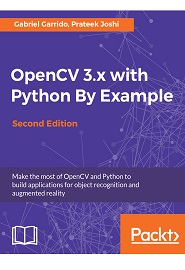
English | 2018 | ISBN: 978-1788396905 | 268 Pages | PDF, EPUB | 241 MB
Learn the techniques for object recognition, 3D reconstruction, stereo imaging, and other computer vision applications using examples on different functions of OpenCV.
Computer vision is found everywhere in modern technology. OpenCV for Python enables us to run computer vision algorithms in real time. With the advent of powerful machines, we have more processing power to work with. Using this technology, we can seamlessly integrate our computer vision applications into the cloud. Focusing on OpenCV 3.x and Python 3.6, this book will walk you through all the building blocks needed to build amazing computer vision applications with ease.
We start off by manipulating images using simple filtering and geometric transformations. We then discuss affine and projective transformations and see how we can use them to apply cool advanced manipulations to your photos like resizing them while keeping the content intact or smoothly removing undesired elements. We will then cover techniques of object tracking, body part recognition, and object recognition using advanced techniques of machine learning such as artificial neural network. 3D reconstruction and augmented reality techniques are also included. The book covers popular OpenCV libraries with the help of examples.
This book is a practical tutorial that covers various examples at different levels, teaching you about the different functions of OpenCV and their actual implementation. By the end of this book, you will have acquired the skills to use OpenCV and Python to develop real-world computer vision applications.
What You Will Learn
- Detect shapes and edges from images and videos
- How to apply filters on images and videos
- Use different techniques to manipulate and improve images
- Extract and manipulate particular parts of images and videos
- Track objects or colors from videos
- Recognize specific object or faces from images and videos
- How to create Augmented Reality applications
- Apply artificial neural networks and machine learning to improve object recognition
Resolve the captcha to access the links!